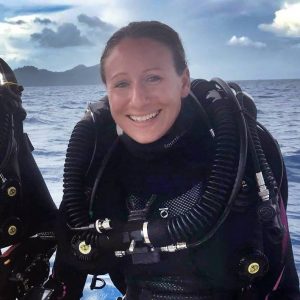Becky is a 5 time Emmy Award winning underwater cameraman and photographer who’s work appears on major networks including National Geographic, Discovery Channel and Red Bull. She specializes in capturing images in extreme underwater environments including caves, under ice and deep shipwrecks. Her projects have taken her all over the world from the Arctic to Antarctic and many exciting locations in between. She’s filmed new wrecks discoveries to cave exploration, science, archeology to diving cage-less with great white sharks. She’s earned a reputation for being able to bring back quality imagery from harsh conditions. Her biggest passion is shooting haunting images of deep shipwrecks in the Great Lakes. She combines her artistic style with powerful stories of tragedy, mystery and survival to ignite the viewers imagination. She’s constantly pushing the limits and trying new techniques to capture the beauty of the underwater world. In the past year she’s been working on photogrammetry and producing 3D models of shipwrecks to showcase them to divers and non divers. It’s another way to bring shipwrecks to life which has always been her goal. She’s a frequent contributor to several Dive Magazines and her photography has been used in books, museums, and advertising. Becky has been actively diving for 26 years and technical diving for 22 of them. She has been an Instructor for 2 decades and is currently an active TDI Mixed Gas Rebreather Instructor. She leads expeditions all over the world to capture unique images that inspire others to explore our planet!
www.LiquidProductions.com & www.MegDiver.com
How and why do you use checklists?
I’ve been actively diving rebreathers all over the world in all types of environments for 14 years and I’m trained on 6 units. I personally use a build check list because I’m typically on a shoot or running a trip and there are a lot of distractions. Using my checklists gives me confidence at the end of a build to know i haven’t missed something. I also use a pre-jump check list that has about 7 important items on it that I strongly believe should start to become the norm when CCR diving.These simple checks could have prevented rebreather deaths over the years and I believe this can prevent future fatal accidents. Even with decades of diving experience and being an active CCR Instructor I don’t take for granted that I’m human and that accidents can happen so why wouldn’t I use every tool in my toolbox to prevent that.
I actively dive 2 units a backmount and a sidemount unit and each has their individual checklist. I always make sure I have that with me when I travel. I have caught many potential issues using a checklist before they became bigger problems. Everything from missing o-rings to pinched o-rings, holes in a counter lung after travel by doing a positive and negative check. I use a laminated build checklist and i like to assemble my unit at least a day before the dive. By doing that it gives me time to fix any issues, and not feel time pressure the day of the dive if something needs work. Checklists have proven to work in other industries like medical and aviation and also work for rebreather diving.
My pre-jump checklist includes the following that I always do when I’m in my unit and before I splash. I have this either on a big laminated sheet that I can see or hand to a divemaster to read off to me or my group and I also have a personal one on a small slate I keep on my gear. I am also fortunate that the 2 main rebreathers I use have built in checklists that I also do (Meg15 and Liberty). I truly believe this checklist is important because it’s the last time to catch an issue or enter the water with gases off. I feel extremely passionate about this pre-jump check list after knowing divers that have lost their lives by not turning their O2 on. I also feel as the rebreather industry evolves and more and more divers are trained on CCR’s we need to evolve.
1. Oxygen is on (turn valve or press manual o2 and watch pressure)
2. Diluent is on
3. Electronics on
4. Computers set with correct mixes
5. Bailout gas is on and BOV is plugged in (if using one)
6. Drysuit gas is on and drysuit is pluged in
7. At a .7 PO2 or higher before entering the water
Checklists aren’t just to use in class or for new rebreather divers, I dive with and see the most experienced divers on the planet using them even when they know no one is watching. I think this says a lot and shows that even when no one is there to set an example for, we are using it because we believe in them.

